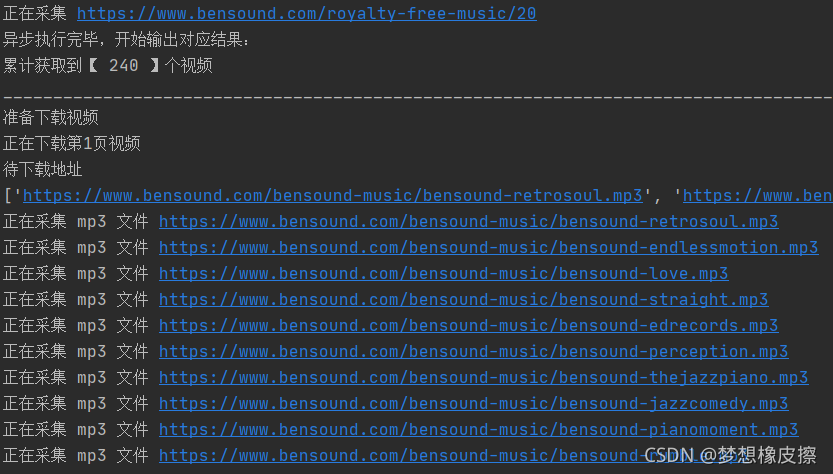本篇博客是第四遍学习协程相关知识,我们在之前内容积累的基础上,新增加一个异步请求库,该库名称为 aiohttp。
为了给大家演示 aiohttp 如何与 asyncio 进行搭配,本文采用代码对比形式进行展示。
异步协程主要用于提高 I/O 操作的效率,所以本次采集的站点依旧以图片为主。
初识 aiohttp 库 - 案例为网易公开课
aiohttp 是一个异步的 HTTP 客户端/服务端框架,它基于 asyncio 模块实现,在《爬虫 120 例》专栏中主要用其客户端能力,提高爬虫的采集速度。
接下来我们将该库与 requests 模块进行对比学习。
requests 模块同步采集 20 次网易公开课
import requestsimport time
def get_html(): res = requests.get("https://open.163.com/") print(len(res.text))
start_time = time.perf_counter()for i in range(20): get_html()
print("requests 同步采集消耗时间为:", time.perf_counter() - start_time)# requests 同步采集消耗时间为: 4.193098181
复制代码
aiohttp 库+asyncio 异步采集 20 次网易公开课
import time
import asyncioimport aiohttp
async def get_html(): async with aiohttp.request('GET', "https://open.163.com/") as res: return await res.text()
async def main(): tasks = [asyncio.ensure_future(get_html()) for i in range(20)]
dones, pendings = await asyncio.wait(tasks) for task in dones: print(len(task.result()))
if __name__ == '__main__': start_time = time.perf_counter() asyncio.run(main()) print("aiohttp 异步采集消耗时间为:", time.perf_counter() - start_time) # aiohttp 异步采集消耗时间为: 0.275251032
复制代码
得到的结论 requests 模块采集 30 遍耗时 4s,而 aiohttp 库耗时 0.3s,相差将近 10 倍。
aiohttp 系统学习直接参考官方文档即可,非常清楚:https://docs.aiohttp.org/en/stable/,注意该模块需要安装,非内置模块。
在本系列专栏中,aiohttp 只会用在客户端,所以仅说明该部分知识点。
请求一个网站,并返回其数据
import aiohttpimport asyncio
async def main():
async with aiohttp.ClientSession() as session: async with session.get("http://httpbin.org/get") as resp: print(resp.status) print(await resp.text())
asyncio.run(main())
复制代码
在 main() 函数中,存在两个对象,第一个是 ClientSession,第二个没有显式标记,它是 ClientResponse,这两个对象分别对应 请求对象 与 响应对象 。
学习 aiohttp 可以对比 requests 进行学习,例如 ClientSession 对象具备不同的 HTTP 请求方法,分别是 get,post,put,post,delete,head,options,patch,其中主要用 get 与 post。
如果你不需要保留请求的会话状态,直接用下述代码即可,通过 aiohttp.request 直接发送请求获取响应。
import aiohttpimport asyncio
async def main(): async with aiohttp.request("GET", "http://httpbin.org/get") as resp: html = await resp.text(encoding="utf-8") print(html)
asyncio.run(main())
复制代码
使用 ClientSession 的好处不用每次请求都创建一个 session,通过第一次创建的 session 对象可以执行所有的请求。
所以在本文的开篇代码,可进行如下修改,不过时间上并无太大变化。
import time
import asyncioimport aiohttp
async def get_html(client): async with client.get("https://open.163.com/") as resp: return await resp.text()
async def main(): async with aiohttp.ClientSession() as client: tasks = [asyncio.ensure_future(get_html(client)) for i in range(20)]
dones, pendings = await asyncio.wait(tasks) for task in dones: print(len(task.result()))
if __name__ == '__main__': start_time = time.perf_counter() asyncio.run(main()) print("aiohttp 异步采集消耗时间为:", time.perf_counter() - start_time)
复制代码
如果希望请求到图片类二进制数据,将上述代码中 await resp.text() 部分,修改为 await resp.read() 即可。如果目标数据源是 JSON 格式的数据,使用 resp.json() 即可。
aiohttp 发送请求时的参数说明
由于不同的请求方式,参数差不多,所以下述内容都使用 get 请求进行说明。
params:该参数用于构造 URL,可以传递的格式有 [("var1",1),("var2",2)],{"var1": 1,"var2": 2},var1=1&var2=2;
headers:请求头;
cookies:请求时携带的 Cookie;
data:用于 POST 请求,参数格式 {"var1": 1,"var2": 2};
timeout:超时设置;
proxy:代理设置;
到这里,初识部分已经说明完毕,接下来就进入到实际的编码环节。
bensound 爬虫编写
本次要采集的目标站点是:https://www.bensound.com/royalty-free-music。该页面包含非常多的 mp3 文件,本篇博客就对其进行采集。
经过分析得知,mp3 的下载地址是:
https://www.bensound.com/bensound-music/bensound-allthat.mp3
复制代码
该地址可以通过列表页相关数据拼凑而来,通过开发者工具得到 mp3 如下封面图地址,再通过 python 字符串操作,获取上述链接。
https://www.bensound.com/bensound-img/allthat.jpg
复制代码
转换代码如下:
img_url = "https://www.bensound.com/bensound-img/allthat.jpg"name = img_url[img_url.rfind("/") + 1:img_url.rfind(".")]
mp3_url = f"https://www.bensound.com/bensound-music/bensound-{name}.mp3"print(mp3_url)
复制代码
转换代码编写完毕,先测试一下通过 requests 模块获取 20 页数据消耗的时间。
import time
import asyncioimport aiohttp
from bs4 import BeautifulSoupimport lxml
async def get_html(client, url): print("正在采集", url) async with client.get(url) as resp: html = await resp.text() soup = BeautifulSoup(html, 'lxml') divs = soup.find_all(attrs={'class': 'img_mini'}) mp3_urls = [get_mp3_url("https://www.bensound.com/" + div.a.img["src"]) for div in divs] return mp3_urls
def get_mp3_url(img_url): img_url = img_url name = img_url[img_url.rfind("/") + 1:img_url.rfind(".")]
mp3_url = f"https://www.bensound.com/bensound-music/bensound-{name}.mp3" return mp3_url
async def main(urls): async with aiohttp.ClientSession() as client: tasks = [asyncio.ensure_future(get_html(client, urls[i])) for i in range(len(urls))]
dones, pendings = await asyncio.wait(tasks) print("异步执行完毕,开始输出对应结果:") for task in dones: print(task.result())
if __name__ == '__main__': url_format = "https://www.bensound.com/royalty-free-music/{}" urls = [url_format.format(i) for i in range(1, 21)] start_time = time.perf_counter() asyncio.run(main(urls)) print("aiohttp 异步采集消耗时间为:", time.perf_counter() - start_time)
复制代码
上述代码,运行过程如下所示。接下来的代码就变得非常简单了,与前一篇博客内容基本一致。
import time
import asyncioimport aiohttp
from bs4 import BeautifulSoupimport lxml
async def get_html(client, url): print("正在采集", url) async with client.get(url, timeout=5) as resp: html = await resp.text() soup = BeautifulSoup(html, 'lxml') divs = soup.find_all(attrs={'class': 'img_mini'}) mp3_urls = [get_mp3_url("https://www.bensound.com/" + div.a.img["src"]) for div in divs] return mp3_urls
def get_mp3_url(img_url): img_url = img_url name = img_url[img_url.rfind("/") + 1:img_url.rfind(".")]
mp3_url = f"https://www.bensound.com/bensound-music/bensound-{name}.mp3" return mp3_url
async def get_mp3_file(client, url): print("正在采集 mp3 文件", url) headers = { "User-Agent": "Mozilla/5.0 (Windows NT 6.1; Win64; x64) AppleWebKit/537.36 (KHTML, like Gecko) Chrome/94.0.4606.61 Safari/537.36", "Referer": "https://www.bensound.com/royalty-free-music" } mp3_file_name = url[url.rfind('-') + 1:url.rfind('.')] print(mp3_file_name) async with client.get(url, headers=headers) as resp: content = await resp.read() with open(f'./mp3/{mp3_file_name}.mp3', "wb") as f: f.write(content) return (url, "success")
async def main(urls): timeout = aiohttp.ClientTimeout(total=600) # 超时时间设置为600秒 connector = aiohttp.TCPConnector(limit=50) # 并发数量设置为50 async with aiohttp.ClientSession(connector=connector, timeout=timeout) as client: tasks = [asyncio.ensure_future(get_html(client, urls[i])) for i in range(len(urls))]
dones, pendings = await asyncio.wait(tasks) print("异步执行完毕,开始输出对应结果:") all_mp3 = [] for task in dones: all_mp3.extend(task.result())
totle = len(all_mp3) print("累计获取到【", totle, "】个 MP3 文件") print("_" * 100) print("准备下载 MP3 文件")
# 每次下载10个 totle_page = totle // 10 if totle % 10 == 0 else totle // 10 + 1
for page in range(0, totle_page): print("正在下载第{}页 MP3 文件".format(page + 1)) start_page = 0 if page == 0 else page * 10 end_page = (page + 1) * 10 print("待下载地址") print(all_mp3[start_page:end_page]) mp3_download_tasks = [asyncio.ensure_future(get_mp3_file(client, url)) for url in all_mp3[start_page:end_page]] mp3_dones, mp3_pendings = await asyncio.wait(mp3_download_tasks) for task in mp3_dones: print(task.result())
if __name__ == '__main__': url_format = "https://www.bensound.com/royalty-free-music/{}" urls = [url_format.format(i) for i in range(1, 5)] start_time = time.perf_counter() asyncio.run(main(urls)) print("aiohttp 异步采集消耗时间为:", time.perf_counter() - start_time)
复制代码
运行截图如下所示,由于 mp3 文件比较大,所以将采集总页数设置为 5 。
上述代码还进行了 ClientSession 的全局设置,代码如下。
timeout = aiohttp.ClientTimeout(total=600) # 超时时间设置为600秒connector = aiohttp.TCPConnector(limit=50) # 并发数量设置为50
复制代码
设置上述参数的原因,由于部分网站的服务器限制单个 IP 建立并行 TCP 连接数量,aiohttp 默认设置连接数量为 100,可以手动调整。超时设置也是由于 aiohttp 默认设置的是 300S(即 5 分钟),如果一个 TCP 连接的持续时间超过这个时间,服务器自动断开该连接。
写在后面
如需完整代码,请查看评论区置顶评论。
今天是持续写作的第 <font color=red>244</font> / 365 天。期待 <font color=#04a9f4>关注</font>,<font color=#04a9f4>点赞</font>、<font color=#04a9f4>评论</font>、<font color=#04a9f4>收藏</font>。














评论